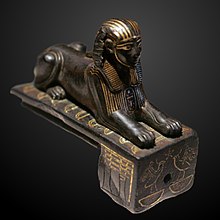
| Nine bows in hieroglyphs | |||
|---|---|---|---|
psḏt pḏt pesedjet pedjet[1] | |||
The Nine Bows is a visual representation in Ancient Egyptian art of foreigners or others.[2][3] Besides the nine bows, there were no other generic representations of foreigners.[3] Due to its ability to stand in for any nine enemies to Ancient Egypt, the peoples covered by this term changed over time as enemies changed, and there is no true list of the nine bows.[3]
Alternatively, the nine bows may have had a separate or complementary meaning.[3] In Egyptian hieroglyphs, the word 'Nine Bows' is spelled out as a bow and three sets of three vertical lines. The bow, holding the phonic value "pḏ," means "stretch, (be) wide," and the three sets of lines makes the word plural.[3][4] The number nine was used metaphorically to express totality.[2] Using this more literal translation of the hieroglyphs, the nine bows could also refer to endless, innumerable foreign lands or the totality of foreign lands.[2][3]![]()
Ancient Egyptians believed in dualism or that two cosmic forces, order and chaos, governed the universe. While the nine bows stood in for Ancient Egypt's enemies, it is also possible that they stood in for disorder as well.[5]
- ^ Middle Egyptian Grammar: The Poetical Stela of Thutmose III: Part I , Dr. Gabor Toth, Rutgers University.
- ^ a b c Cite error: The named reference
:3was invoked but never defined (see the help page). - ^ a b c d e f Tait, John (2003). 'Never Had the Like Occurred': Egypt's view of its past. Great Britain: UCL Press. pp. 155–185. ISBN 9781315423470.
- ^ Griffith, F. Ll.; Gardiner, Alan H. (November 1927). "Egyptian Grammar, Being an Introduction to the Study of Hieroglyphs". The Journal of Egyptian Archaeology. 13 (3/4): 279. doi:10.2307/3853984. ISSN 0307-5133. JSTOR 3853984.
- ^ Waziry, Ayman (2019). "An Unpublished Pedestal of Ramses II from Antinoopolis with Reference to the Nine Bows". Journal of Ancient History and Archaeology. 6: 14–29. doi:10.14795/j.v6i1.365.